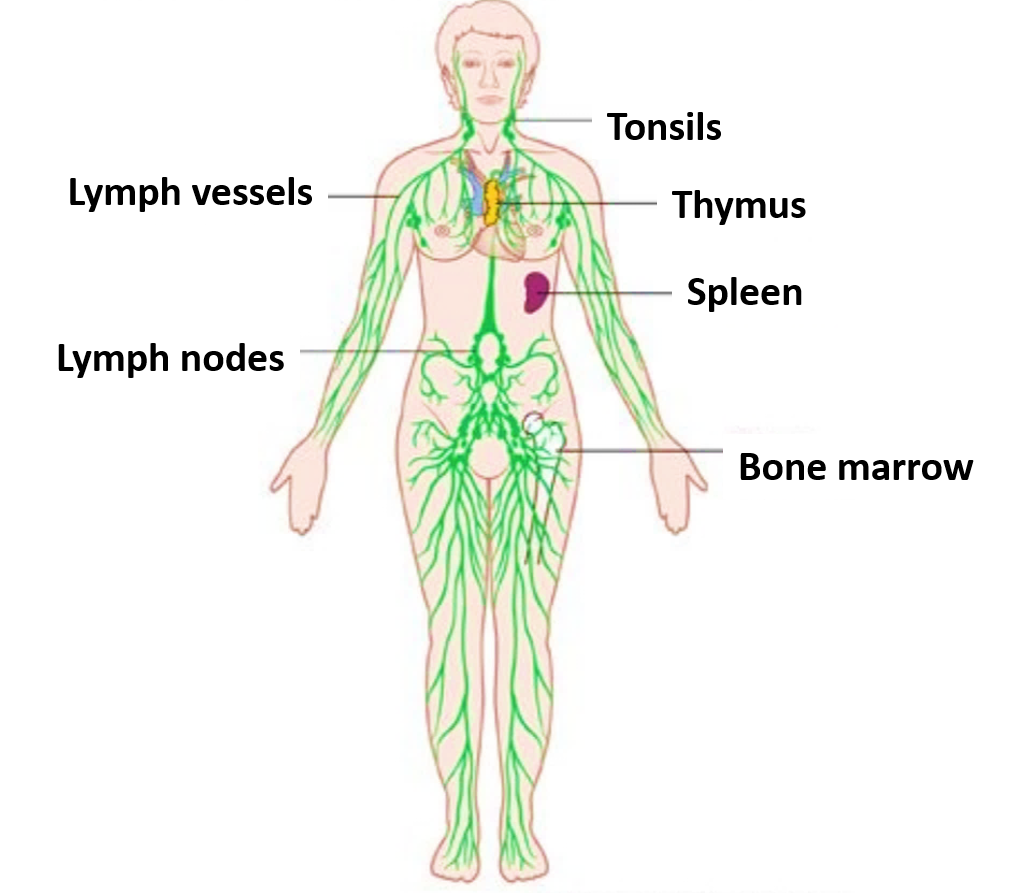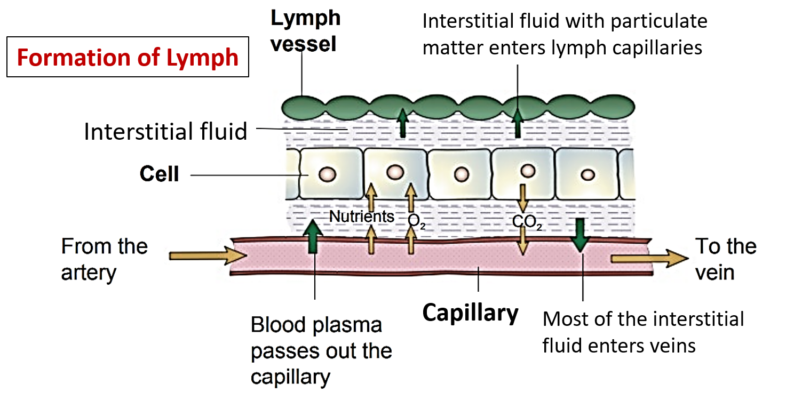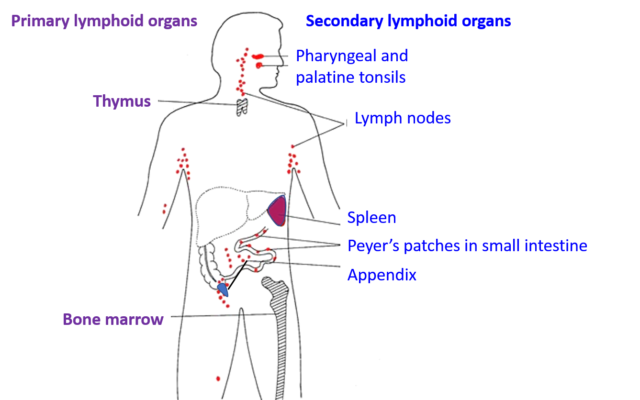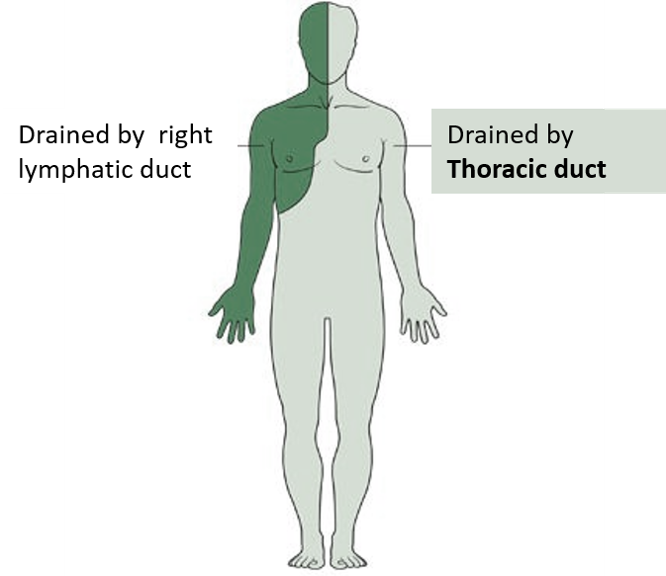What are the functions of lymphatic system?
Lymphatic system is a subsystem of the circulatory system, consisting of complex network of vessels, lymph nodes and other lymphoid organs.
The functions of lymphatic system are:
- The primary function of the lymphatic system is to transport lymph, a clear, colorless fluid containing white blood cells
that helps rid the body of toxins, waste and other unwanted materials. - Protects the body from the disease-causing agents.
- Transports interstitial fluid formed as a blood filtrate back to blood and thus help in maintaining fluid balance.
- Serves as the route by which absorbed fat from the small intestine is transported to the blood.
What are the components of the lymphatic system?
- Circulating lymphocytes.
- Lymph vessels.
- Central ( primary) lymphoid organs : bone marrow and thymus.
- Peripheral (secondary) lymphoid organs : lymph nodes, spleen tonsils, mucosa associated lymphoid tissue.

Explain the general plan of drainage of lymph.
As the arterial blood circulates through the body, blood plasma leaks into tissues through the thin walls of the capillaries. Blood plasma that escapes from the capillaries and surrounds the cells is called interstitial or extracellular fluid and it contains oxygen and nutrients. Most of this fluid goes back into the veins however some of this fluid along with the particulate matter is left behind. This fluid enters the lymph capillaries and is returned via the lymphatic vessels to the bloodstream.

General Plan of Drainage of Lymph

Name the factors that help in lymph flow.
Factors that help in lymph flow are:
- Tissue fluid pressure
- Contraction of surrounding muscles
- Pulsations of adjacent arteries
- Negative intrathoracic pressure
- Presence of valves which prevent back flow
Name the sites where lymphatic capillaries are absent.
- All avascular structures
- epidermis
- cornea
- nail
- hair
- cartilage.
- Spleen and bone marrow.
- Alveoli and respiratory bronchiole.
- Brain and spinal cord
Name the primary and secondary lymphoid organs.
Primary lymphoid organs are:
- Bone marrow
- Thymus
Secondary lymphoid organs are:
- Lymph node
- Spleen
- Tonsil
- Mucosa associated lymphoid tissue
o Gut associated lymphoid tissue (GALT)
o Bronchi associated lymphoid tissue (BALT)

Name the areas drained by thoracic and right lymphatic ducts.
Areas drained by thoracic duct are:
- Lower limbs
- Left side of head and neck
- Abdomen
- Left thoracic region
- Left upper limb
Areas drained by right lymphatic duct are:
- Right upper extremity
- Right thoracic region
- Right side of head and neck

What are the types of lymphocytes and their function/s?
There are two types of lymphocytes:
B lymphocytes:
o Are derived from precursor cells in bone marrow and they also mature within the bone marrow.
o Mature cells migrate to secondary lymphoid organs.
o On being exposed to antigens they proliferate and produce antibody producing cells – plasma cells, and memory cells.
o Are responsible for antibody mediated ( humoral ) response.
T lymphocytes:
o Immunologically immature T lymphocytes migrate from bone marrow to thymus.
o Immature T lymphocytes proliferate and acquire variety of surface markers and become immunologically competent cells.
o Types of T lymphocytes:
T helper cells
Cytotoxic T cells
Suppressor T cells
o Are responsible for cell mediated antibody.
Applied Aspects
Lymphangitis
• Is the inflammation of the lymphatic vessels .
• Is caused by inflammatory conditions of the skin caused by bacterial infections.
• Thin red lines may be observed running along the course of the lymphatic vessels in the affected area,.
• Is accompanied by painful enlargement of the nearby lymph nodes.
Lymphadenitis
• Occurs when the lymph nodes become overwhelmed by bacteria, virus, fungi, cancer cells, or inflammation.
• The swollen lymph nodes are usually found near the site of an underlying infection, tumor, or inflammation.
Elephantiasis
- Massive swelling and enlargement of the limbs resembling elephant’s leg.
- Adult worms of filariasis are lodged in the lymph vessels of leg and foot which causes blockade of lymph flow and as a result fluid accumulates in interstitial spaces leading to edema.


Superb
Verynice quite explainatery
thank you